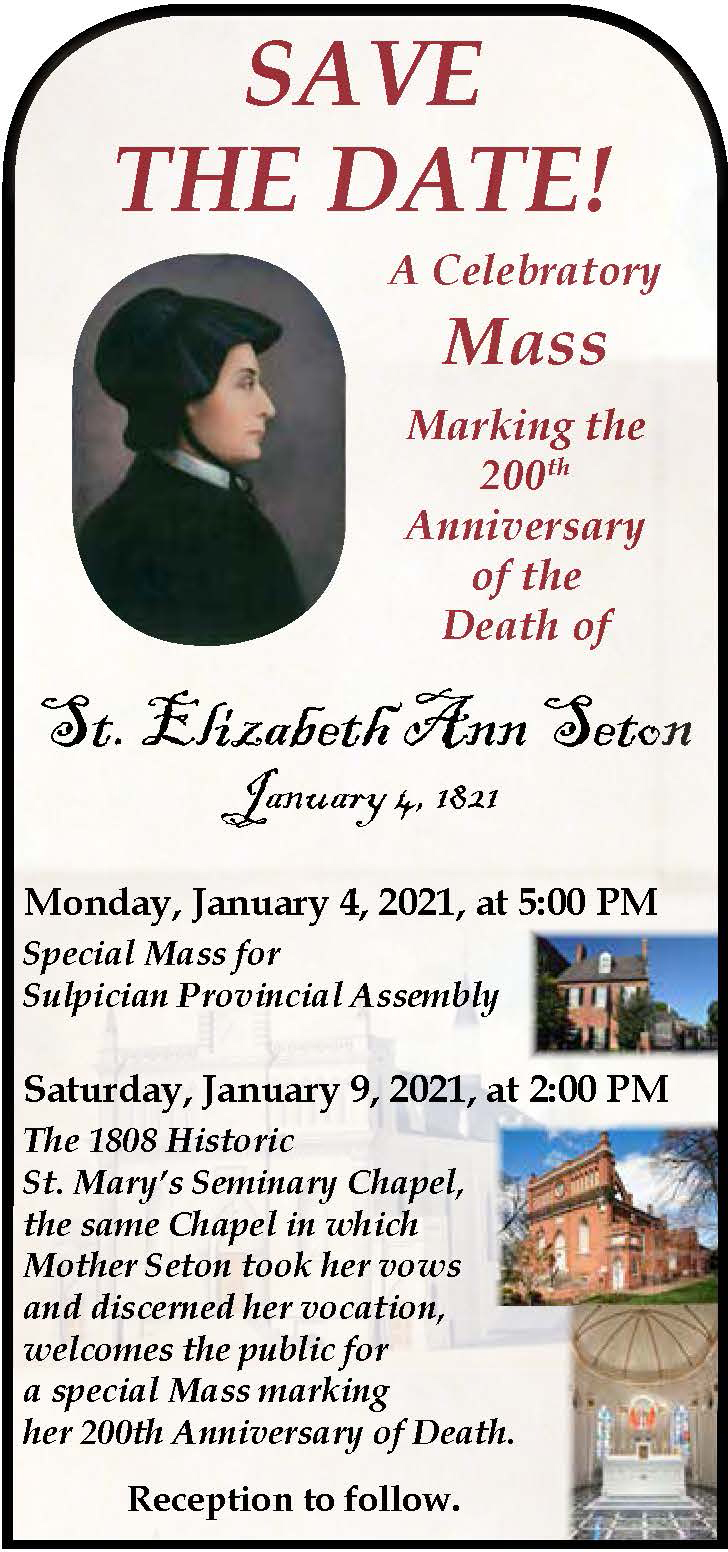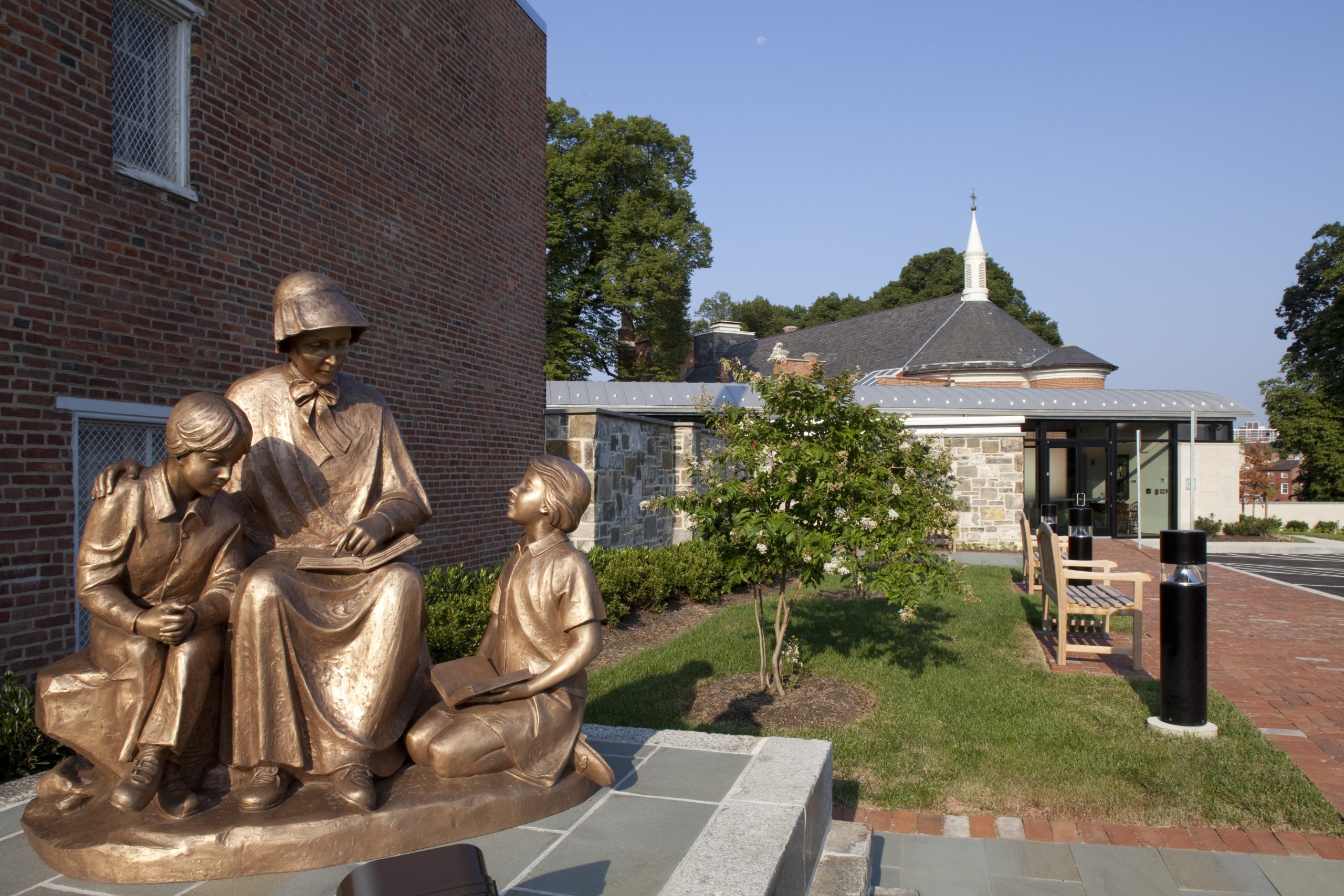Mother Seton statue at St. Mary’s Spiritual Center & Historic Site.
Link by Link [1]
When Elizabeth Bayley Seton resolved to embrace the Catholic faith, she was of the mind: “I … trust all to God–it is his affair NOW.”[2] Sailing toward Baltimore aboard The Grand Sachem, Mrs. Seton wrote: “Tomorrow—do I go among Strangers? No.”[3] God had entrusted her destiny to the Reverend Gentlemen of the Seminary.[4]
Mrs. Seton providentially met Rev. William Dubourg, PSS, in New York. He invited her to begin a boarding school at Paca Street in Baltimore, Maryland. His “plan of life” for the young, devout widow and mother included forming a sisterhood. Dubourg asked his confreres to recruit candidates.[5] Rev. Pierre Babade, PSS, recommended the first, Cecilia O’Conway of Philadelphia.
The émigré Sulpicians knew of the Filles de la Charité service of impoverished persons throughout France. The priests sought to replicate the apostolic community, founded by Saints Louise de Marillac and Vincent de Paul. A wealthy seminarian at St. Mary’s financed the purchase of property for the sisters but specified its location– Emmitsburg, not Baltimore.[6] When Mrs. Seton made private, annual vows at St. Mary’s, Archbishop Carroll gave her the title “Mother Seton.”
Rev. John Dubois, PSS, graciously provided accommodations at The Mountain for the first group to arrive, since their old farmhouse was not yet ready for occupancy. Although organized at Paca Street, the Sisters of Charity of St. Joseph’s, was founded July 31, 1809, in St. Joseph’s Valley. Their ecclesiastical superior would be a Sulpician priest. Rev. François Nagot, PSS, superior in the United States, appointed Dubourg the first Sulpician superior.
Dubourg gave the Sisters provisional rules, their first retreat, initial spiritual formation, but immediately began, “acting like a tyrant,” and resigned abruptly. The issue involved his longstanding tension with Rev. Pierre Babade, PSS, whom the Sisters esteemed.[7] Despite Elizabeth’s protest, Nagot appointed a new Sulpician superior for the sisterhood, Rev. John B. David, PSS.
David knew that the Bishop- elect, Benedict Flaget, PSS, was about to depart for Paris. He immediately requested Flaget to obtain the Common Rules of the Daughters of Charity. Flaget did so, but also requested Filles de la Charité to come to America, either as mentors, or to facilitate a union. Elizabeth Seton opposed the latter. Providentially, Napoleon refused them passports. David’s authoritative manner and disdain for female competency triggered personality clashes with most of the sisters. He resigned and departed for Kentucky at Flaget’s invitation.
Rev. John M. Tessier, PSS, superior of the Sulpicians in the United States in 1810, then appointed Dubois, Sulpician superior. Dubois and Mother Seton discussed the Daughters of Charity rules and recommended adaptations for the United States. Dubois translated the Rules into English and discussed them with the Sisters before sending the manuscript to Tessier and the Archbishop for approval in January 1812.
Dubois’s congenial style characterized his ten years of collaboration with Mother Seton. Together they established the school at St. Joseph’s. A hard- working man of integrity, he was a practical businessman with pastoral sensitivity, and became a trusted mentor for William and Richard Seton. Tireless as a sacramental priest, even in freezing weather Dubois galloped on horseback to celebrate Mass. Mother Seton referred to him as a “superexcellent Priest.”[8]
Mother Seton befriended numerous seminarians. Her respect for the priesthood and sacred liturgy caused her to scold Rev. John Hickey, PSS, for a poorly prepared sermon, telling him: “If you will not study and prepare while young, what when you are old?”[9]
Mother Seton forged a deep spiritual friendship with Rev. Simon G. Bruté, an erudite bibliophile, whom she helped to improve his English pronunciation. She even wrote some of his sermons. Bruté and Dubois formed the Sisters of Charity in the Vincentian tradition, planting the charism in American soil. Both ministered to Mother Seton at her death, January 4, 1821.
Mother Seton would have described her links to the Sulpicians as fifteen years of blessings which led her to Divine Love: “Link by link the blessed chain … one Body in Christ … who could escape this bond of unity, peace, and love–O my Soul be fastened link by link.”[10] Saint Paul VI canonized Saint Elizabeth Ann Seton 14 September 1975.
Betty Ann McNeil, DC
Vincentian Scholar-in-Residence and
noted Elizabeth Ann Seton scholar
Endnotes
[1] Title derived from “Link by link the blessed ” See 11.57, Prayer Book Inscription, Regina Bechtle, S.C., and Judith Metz, S.C., eds., Ellin M. Kelly, mss. ed., Elizabeth Bayley Seton Collected Writings, 3 vols. (New City Press: New York, 2000- 2006), 3b:108. Hereinafter cited as CW.
[2] 3.31, Journal to Amabilia Filicchi, [February-March 1805], CW, 1:374–5.
[3] 5.1, to Cecilia Seton, 9 June 1808, CW, 2:5.
[4] 5.3, To Julia Scott, 4 July 1808, CW, 2:14.
[5] 5.4, To Antonio Filicchi, Baltimore 8 July 1808, CW, 2:18.
[6] Samuel Sutherland Cooper, retired sea captain and recent convert of
[7] 6.4 To Archbishop John Carroll, [August 6, 1809], CW, 2:78.
[8] 6.39, To Antonio Filicchi, 20 May 1810, CW, 2: 126-30.
[9] 6.195, To Simon Bruté, 8 May 1815, CW, 2:323.
[10] 11.57 Prayer Book Inscription, CW, 3b:108.


